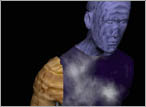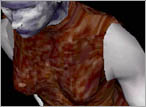| http://www.walkerart.org/salons/shockoftheview/hybrid/hybrid2.html |
|
Victoria Vesna From an imagined global community to a concrete corporate one, artist Victoria Vesna takes up the visual metaphor of the body-in-pieces to figure a new elemental species. "Bodies© INCorporated" is a art project based at University of California Santa Barbara. It was created by Victoria Vesna and a team of collaborators including Robert Nideffer, Nathanial Freitas, Kenneth Fields, Jason Schleifer and others. Probably better described as a dystopia than a utopia, the site is designed to allow users to "build out bodies in 3-D space, graphically visualizing what were previously bodies generated as text-only." "Bodies© INC" clearly situates its origins within the world of avatar manufacturers, yet it also foregrounds the manner in which bodies can be conceived as part of a corporate or institutional structure in contemporary capitalist culture. It hovers in its own liminal space, a pun on the term "incorporated" that becomes a simultaneous critique of corporate culture and a capitulation to its terms of enunciation. For example, as with many other on-line WEB sites, visitors to the site must agree to recognize and abide by various copyright restrictions, legal disclaimers, and limits of liability--including liability for disappointment in the outcome of the body one constructs. This witty, self-conscious irony runs throughout the text of the site, drawing upon the rhetoric of advertising as well as making subtle and often satirical gestures toward the politics of identity and, in this case, the very notion of satisfaction guarantees--or the lack thereof--in the complex construction of a bodily identity. For here the construction of a hybrid body is expressly linked to the construction of identity. The opening page of the site welcomes the new visitor, who is informed that the site "functions as an institution through which your body gets shaped in the process of identity construction that occurs in, and mutually implicates, both the symbolic and material realms." What exactly these realms are, or how they operate is not discussed, though it is suggested that symbolic and material realms, conceived apriori as incommensurate in the real world, are here seen to co-exist, to be one and the same, or at least to be mutually implicated. I would argue it cannot be otherwise, and that the computer is a no more privileged space for this overlay than any other. The more important equation is that between the shaping of the body and the construction of identity, the former being the apparent process by which the latter is achieved. While this equation echoes the assumptions of eugenics, it also can be read, alternatively, as a progressive assertion that identities are always inseparable from corporeal encounters and the symbolic inscription of bodily signs. The corporate rhetoric continues in the assertion that the body created "becomes the personal property" of the person who assembled it. The notion of the body as property also has its own historical connotations, not only in the traditional examples of prostitution and slavery, but also in a contemporary moment when body parts, organs and vital tissues are bought and sold on a black market. Body parts are also for sale in "Bodies© INC", and the more shares the user accrues, the more parts he or she can buy. "Bodies© INC" aptly reconstructs the bureaucracy that inspired its inception, drawing attention to bodies threaded through the paperwork of birth and death certificates, census forms, and medical records, and simultaneously emphasizing the necessity and ludicrous limits of creating selfhood through the apparati of checked boxes and a narrow range of multiple choices. Here birth and death are in fact reduced to nothing but the mechanical act of filling out a form--accompanied by the frustration of waiting indefinitely (appropriately) to see the body-object one has created to appear as a visual model in 3-d graphics. The process of constructing a body in "Bodies© INC" is something like a narrative list that sensitizes the user to the categories of identity and identification already standardized in the culture at large. "Bodies© INC" thus establishes its own community of bodies with symbolic meaning intimately tied to a surface texture. Given the kinds of images available on the WEB this gesture is probably groundbreaking, though it remains to be seen how successful it is in de-sexualizing the body, as the representative forms in Bodies© INC are a kind of tall, slim decidedly Euro-American ideal. Indeed, to construct a fat body or to produce an unusual or monstrous body in this context requires more shares and expertise. Textures are also a convenient solution to the problem of skin color(s). Yet, the progressive potential of a rejection of racial typology falls into its own essentialism when character traits are equated with physical attributes, and limited to a prescribed system of behaviors. What emerges from the avialable choices is a set of corporate typologies -- the fiery team leader, the gray, melancholy, feminine organizer, the dry diplomat, the black, stylish sublimator -- that are simultaneously humorous and disturbingly familiar; familiar, because they combine traits that are already linked in the popular preconscious of the culture at large (the melancholy female, the reactive corporate leader) in the form of archetypes or stereotypes. Hybrid figures may also be composed of different elements, perhaps even a schizophrenic set of surfaces that may implicate the body in a set of conflicting power relations. While ironic and sophisticated these body textures may still be problematic for those who already identify as ´black' or ´bronze'. Vesna's "Bodies© INC" has extensive written documentation on the WEB site that creates a meta-discourse for the user. One can read for example the genealogy of the project, general information about the site, and even an essay by Christopher Newfield that conceptually locates Bodies© INC as a specific kind of corporate structure that ...establishes a virtual corporation as an 'active community' of participants who choose their own bodily form. The primary activity is the creation of a body in exchange for which the creator is given a share of stock. Corporation B thus exists to express each members' desire about his or her physical shape. Production serves self-creation. Firm membership formally ratifies expression. These expressions have none of the usual limits: men become women; black becomes white and white becomes brown; flesh turns to clay, plastic, air; clay, plastic, air are attached on one body. Bodies need be neither whole nor have parts that fit. Indeed this work clearly produces what I have called an appended subject whose limbs and flesh are accessorized, linked to personality traits, and used as values of exchange. The miscegenation of this world is one of hot and cold, wet and dry, mind over matter. But the underlying notion of easily transformed gender and skin color "men become women; black becomes white and white becomes brown" may more accurately denote the fantasies inherent in the project. To her credit, Vesna writes, "There is a need for alternate worlds to be built with more complex renditions of identity and community building and not simply replicating the existing physical structures or hierarchies." She also comments that "Bodies© INC" is conceived "...with the intention of shifting the discourse of the body from the usual idea of flesh and identity. Every members' body represented is the locus of the contradictions of functioning in the hi-tech environment, while being in the Meta-Body, the Entity in the business of service." Vesna here maps the internal logic of her own work, criticizing and at the same time reproducing a corporate ontology. This text is excerpted from a longer work entitled "The Appended Subject: Race and Identity as Digital Assemblage" forthcoming in Race in Space: Politics, Identity and Cyberspace from Routledge. Further discussion of a visual history of hybrid and cyborg bodies can be found in the essay "Envisioning Cyborg Bodies: Notes from Current Research" in The Cyborg Handbook, Routledge, 1995. It was excerpted for "Shock of the View: Artists, Audiences, and Museums in the Digital Age"http://www.walkerart.org/salons/shockoftheview/hybrid/hybrid2.html |


